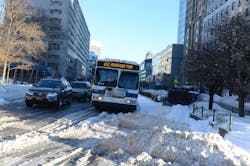Mother Nature threw a curveball past New York City recently when a weather event originally predicted to be a routine 6- to 10-inch January snowstorm developed into a monstrous blizzard that amassed snowfall totals only 1/10 of an inch behind the worst snowstorm in the city’s history.
Recognizing the uncertainty of the weather forecasts, MTA New York City Transit was prepared for the higher totals with a new operations plan that limited subway service to underground portions — about 60 percent of the system’s 469 stations — and totally suspended bus service. The subway service change was accompanied with a special subway map outlining the limits of service and that modified subway map was posted prominently on the mta.info website and on NYC Transit’s Twitter and Facebook pages.
However, that was only the beginning of NYC Transit’s efforts to keep weekend customers informed of what was running, how long it would run and when service was scheduled to resume. Over the past few years, NYC Transit’s network of digital signage assets has grown. It has taken advantage of digital signage, which is displayed prominently on the system’s On The Go (OTG) Travel Station kiosk network inside of stations, as well as Digital Urban Panels, installed at street-level station entrances across Manhattan and parts of Brooklyn. Combined, these assets are integral components of the holistic approach to customer communications, in which the customer is at the center of a consistent and continuous informational messaging experience across channel, format and device.
NYC Transit worked with Outfront Media to push pre- and post-storm messaging on the highly visible Digital Urban Panels, and worked with Outfront and Intersection on messaging to the OTG kiosks inside of subway stations.
“Our digital signage messaging had to be dynamic so that we could reflect changes in service via these highly visible screens. Three years on, we knew from Superstorm Sandy that our digital assets were a huge game changer in terms of our ability to communicate with customers before they entered the system,” noted Paul Fleuranges, vice president of corporate communications. “That message was just as important this time, as we alerted subway and bus customers exactly when bus service would be suspended, and told subway customers when underground-only service would begin.”
Installation is ongoing, but so far, there are 108 of the double-sided Digital Urban Panels affixed to entrance railings at 48 stations. Additionally, there are currently 169 On the Go Travel Station Network (OTGN) kiosks installed at 31 subway stations serving 1.51 million riders daily.
The decision to suspend all bus service and portions of the subway were heavily broadcast through the media, but it remained NYC Transit’s responsibility to make certain that information was readily available to and easily understandable by our customers in system. “It is always our goal to create and present messages that customers can quickly and easily digest. With the blizzard messaging we wanted it to both inform customers about upcoming service changes as well as announcing plans to suspend above-ground subway and all bus service at a given time,” added Connie De Palma, assistant vice president of marketing & service information.
Once approved, NYC Transit had to push the emergency content to screens, but that meant interrupting the normal advertising-supported loop displayed on the Digital Urban Panels and the new OTGN kiosks in subway stations.
The first series of messages were displayed on all screens at 7:00 a.m. on January 22, informing customers of the winter weather ahead, urging them to be careful and explaining what impact the weather could have on service. As the storm bore down on Saturday and the decision to suspend all local, limited and express bus service was made, updated content was posted to digital signage assets at 10:30 a.m. warning of the noon curtailment. That message was updated a few hours later when service was shut down. Content on the digital screens was updated again with information and a map showing the new underground-only subway service at 2:40 p.m.
The next challenge was the creation and posting of messaging announcing the decision to restore service. Despite working from home, the team stayed in constant touch by regular conference calls and by e-mail throughout the weekend. Content producers and graphic artists continued to work to fine tune the post-storm messaging as rail and road conditions from the snowfall were assessed. Shortly after midnight on Sunday, January 24, The digital signage was updated with planned bus restoration information, with that messaging updated hours later as service was restored at 7:00 a.m.
As service on exterior subway routes came on line shortly after 9:00 a.m., new content was pushed to the screens and updated as line segments were reopened. This messaging was updated throughout the day on Sunday, along with messaging highlighting snow removal efforts by the crews. New messaging was created and scheduled to run Monday morning detailing service plans for the first workday after the storm.
Digital signage is increasingly becoming a go-to channel for NYC Transit, whether it is daily service information or extreme weather or other emergency events. The customers have come to rely on this impactful communications medium for information. The challenge is in being prepared and having the right procedures in place to create and push content as efficiently as possible.
Charles Seaton is the director, marketing at MTA New York City Transit.
